Festivals in the Philippines reflect the country’s culture and rich history. Key celebrations include Sinulog, Ati-Atihan, and Panagbenga.
The Philippine archipelago boasts a colorful array of different festivals that showcase its diverse cultural heritage and religious traditions. Tourists and locals alike revel in these fiestas that are characterized by street dancing, elaborate costumes, and sumptuous feasts. Each Philippine province and city takes pride in their unique festivals, often rooted in Catholic traditions and frequently merged with indigenous practices.
Such events not only offer glimpses into the Filipinos’ deep devotion and communal spirit but also highlight the country’s love for music, dance, and art. The joyful ambiance, coupled with the Filipinos’ warm hospitality, turns these festivals into unforgettable experiences. Filipino festivals are powerful tourist magnets, providing a dazzling spectacle of the nation’s soul and becoming pivotal occasions for visitors to grasp the dynamic Philippine way of life.
Top 26 Religious Festivals in the Philippines
1. Ati-atihan
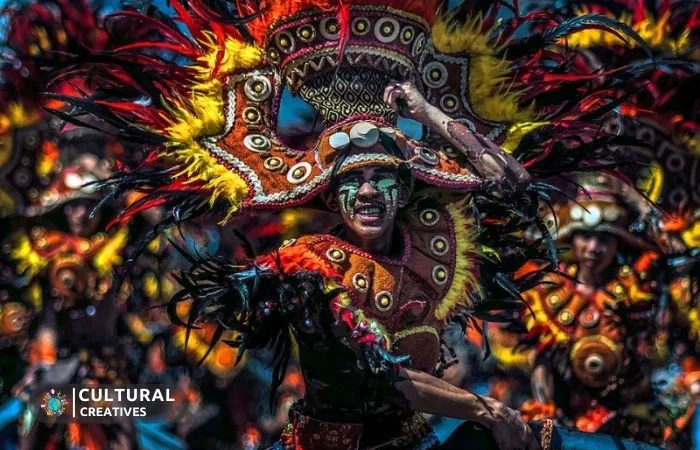
The Ati-Atihan Festival emerges as a testament to the rich cultural tapestry that defines this island nation. Celebrated annually in January in the streets of Kalibo, Aklan, it is a feast for the senses, a time when rhythmic drumbeats and melodic chants fill the air, while dancers adorned in flamboyant costumes take to the streets, their bodies painted in a myriad of hues.
This spectacle is more than just a traditional display; it is an embodiment of the Filipino spirit of communal unity, religious devotion, and cultural pride.
Historical Significance
Before we delve into the colorful chaos of the Ati-Atihan Festival, let’s take a moment to understand its origins:
- Cultural Fusion: The festival commemorates the historic barter of Panay Island by the Ati people to the Malay datus. It represents the synthesis of indigenous cultures with Malay influences.
- Christian Integration: This once-pagan festival was later assimilated into the Christian faith, now commemorating the Santo Niño (Holy Child Jesus). It underscores how pre-colonial customs were harmoniously integrated with Christian practices.
Celebrations And Activities
With every beat of the drum and every step in the procession, participants in the Ati-atihan Festival perform with unfaltering enthusiasm. Here are the activities that bring life to this festival:
- Street Dancing: The core of the festivities, participants perform passionate dances to the beat of indigenous percussion. The energy of the dancers is infectious, with the crowd often joining in.
- Costumes: Each participant dresses in an array of elaborate costumes, often featuring feathers, beads, and headdresses. This visual pageant is a feast for the eyes and a photographer’s delight.
- Religious Elements: Masses and processions pay homage to the Santo Niño. Devotees demonstrate their faith through dance, prayer, and offerings, adding a profound depth to the celebrations.
Why Attend Ati-atihan?
Wondering why you should experience Ati-Atihan firsthand? It boils down to these unmissable highlights:
- Cultural Immersion: There’s no better way to connect with Filipino heritage. The festival allows you to witness and partake in the history and tradition that continue to shape the nation.
- The Fiesta Atmosphere: Immerse yourself in the non-stop party vibe of the Ati-Atihan. The energy and spirit of camaraderie are uplifting and truly one-of-a-kind.
- Unique Crafts and Cuisine: Take home a piece of the festival with intricate handicrafts, and don’t miss out on savoring local delicacies that encapsulate the soul of Filipino cuisine.
The Ati-atihan Festival promises an unparalleled cultural journey that tantalizes the senses, rejuvenates the soul, and offers a window into the celebratory spirit and historical roots of the Filipino people. If you’re a cultural aficionado or a spirited traveler, the Ati-Atihan experience is one that deserves to be on your bucket list.
2. ibalong
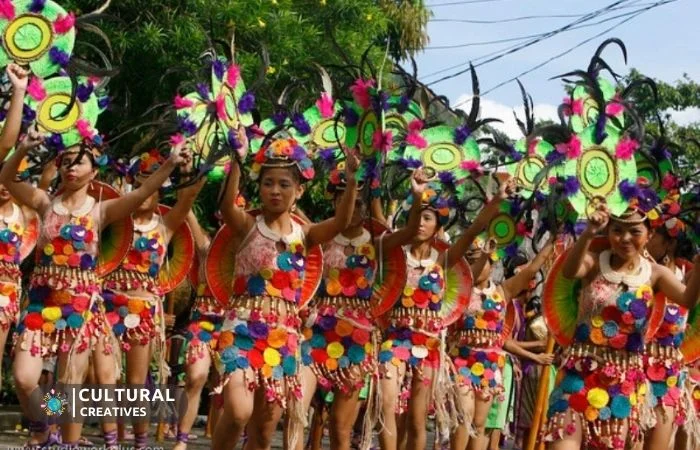
The Ibalong Festival is a colorful spectacle celebrating the rich cultural heritage of Legazpi City, Philippines. This event features street dances, elaborate costumes, and reenactments of epic Bicolano myths, drawing both locals and tourists to its lively festivities.
Celebrated with energy and enthusiasm, the Ibalong Festival is a testament to the rich cultural heritage of the Bicol Region in the Philippines. This annual event turns the streets of Legazpi City into a colorful spectacle, resonating with the epic story of Baltog, Handyong, and Bantong — legendary heroes from the region’s folk history.
History And Origin
The Ibalong Festival is steeped deeply in the history of the Bicol people. It derives its name from the epic poem “Ibalong,” which chronicles the heroic feats of ancient warriors fighting against formidable beasts and villains to bring peace to their land.
Festival Activities
Let’s take a glimpse at the lively activities that bring the Ibalong Festival to life:
- Street Dancing: Participants clad in elaborate costumes dance to the rhythm of drums, portraying scenes from the “Ibalong” epic.
- Legends and Cultural Exhibits: Exhibits display the rich narrative and the artistic interpretations of the ancient heroes and their adventures.
- Sports Competitions: These celebrate the physical prowess reminiscent of the heroes’ strength and skills portrayed in the epic.
- Cooking Competitions: Showcasing the sumptuous Bicolano cuisine, mirrors the cultural identity of the region and pays homage to traditional culinary arts.
Reasons To Attend
One cannot completely grasp the spirited soul of the Bicolanos without experiencing the Ibalong Festival first-hand. It is a delightful fusion of art, history, and culinary delights that engages all senses.
Tips For Visitors
To ensure a memorable festival experience, consider these helpful suggestions:
- Wear Comfortable Clothing: Opt for light, airy outfits suitable for the tropical climate and a day full of activities.
- Hydration is Key: Always carry a bottle of water to stay hydrated during the long, excitement-filled day.
- Respect Local Customs: Honor the cultural significance of the festival by being mindful and considerate of local traditions and practices.
3. sinulog
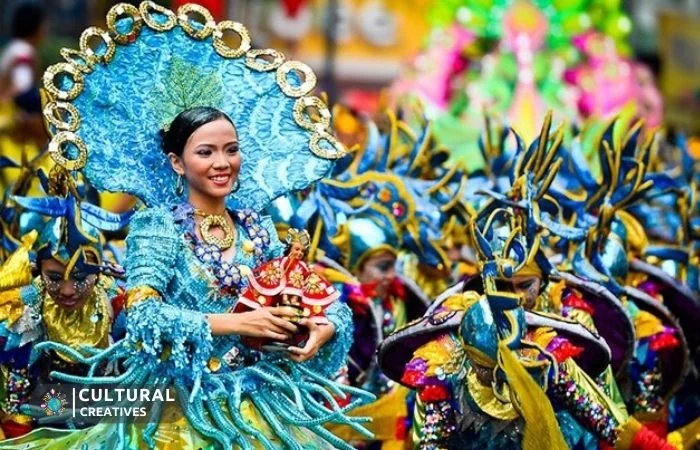
Every third Sunday of January, the island of Cebu bursts into an array of colors and pulsating rhythms as it celebrates Sinulog, one of the Philippines’ most spectacular and attended Festivals in the Philippines. Rife with cultural significance, Sinulog is a jubilant time that draws visitors from across the globe to witness a unique blend of tradition, dance, and devotion in honor of the Santo Niño or the Child Jesus.
A Glimpse Into History
Sinulog’s origins are as colorful as the festival itself, starting as a pagan ritual and evolving into a grand Christian celebration:
- Pre-Spanish roots: Indigenous dances in honor of animistic deities.
- The introduction of Christianity: Magellan’s gifting of the Santo Niño to Rajah Humabon’s wife, harmonizing local customs with newfound faith.
- The name ‘Sinulog’: Derived from the Cebuano word for the dance’s water-like movement, akin to the river’s current.
Dance, Music, And Devotion Collide
At the heart of the festival lies the Sinulog Grand Parade, a spectacle that brings the city to life with its elaborate costumes and choreographed performances:
- The Street Dance: Performers glide and step to the percussive beat, depicting the rhythmic flow of water.
- The costumes: Bursting with hues, feathers, and beads, symbolizing the richness of Cebuano culture.
- The religious processions: Devotees carrying the image of Santo Niño through the streets, their faith unwavering amidst the revelry.
Impact And Significance
Overflowing with spiritual and cultural essence, Sinulog has a resounding impact on both the local community and international perceptions of Philippine festivities:
- Cultural preservation: Acts as a catalyst for younger generations to engage with and uphold Cebu’s rich cultural heritage.
- Economic boost: Attracts tourists, promoting local crafts and businesses, significantly contributing to Cebu’s economy.
- Global recognition: Puts the Philippines on the map as a destination for culturally immersive and exceptional celebrations.
Sinulog Festival stands as a testament to the Philippines’ capacity to blend faith, fun, and folklore into a tapestry of traditions that continue to enchant the world. It’s more than a festival; it’s a phenomenal expression of a nation’s soul—a must-experience spectacle for anyone fascinated by cultural depth and diversity.
4. mango
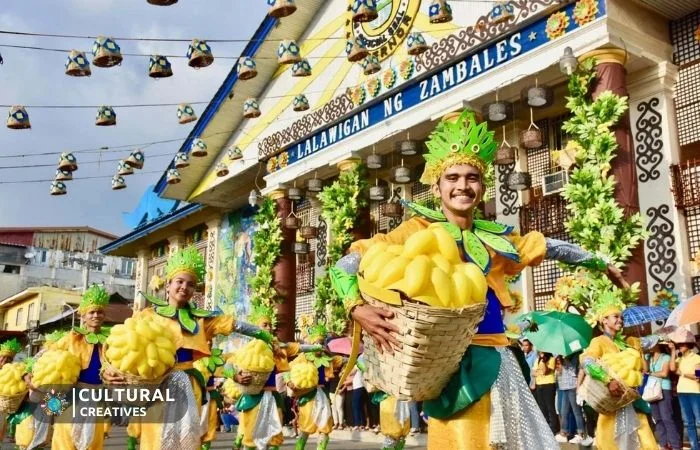
Celebrate the Mango Festival in the Philippines, a sweet homage to the nation’s favorite fruit. Visitors get immersed in a colorful array of mango-centric festivities, crafts, and culinary delights.
Philippines is a kaleidoscope of festivities, and among them, the Mango Festival stands out with its celebration of one of the country’s most loved fruits. Let’s peel back the layers of this juicy event that honors the ‘king of fruits’ and discover why it’s a must-visit fiesta for fruit aficionados and cultural enthusiasts alike.
Mango Festival Location And Origin
Exploring the roots of the Mango Festival takes us to the sun-soaked shores of Zambales, a province widely revered for its sweet and succulent mangoes. The festival not only commemorates the harvest of this golden fruit but also:
- Mango Varieties: Celebrates the diversity of mango species grown in the region and their unique flavors.
- Cultural Significance: Pays homage to the agricultural heritage and the farmers’ hard work in cultivating these delicious fruits.
Highlights Of The Mango Festival
A festival wouldn’t be complete without its share of highlights, and the Mango Festival offers a basket full of activities. Chapter by chapter, this festivity is a living storybook of the Philippines’ love for mangoes:
- Mango Eating Contest: An exciting challenge where participants race to devour mangoes.
- Street Dancing: A kaleidoscope of colors and movements, as dancers portray the mango harvest through lively performances.
- Agricultural Show: A showcase of the finest mangoes and other local produce, often including competitions for the best produce.
Mango Festival Impact On Tourism
The Mango Festival has ripe benefits for the local economy, particularly in the tourism sector. Visitors flock from all corners to witness and participate:
- Cultural Exchange: Tourists get a slice of local life, enriching their travel experience with authentic cultural immersion.
- Boost to Local Businesses: From accommodations to souvenir shops, a surge in visitors creates a buzz of economic activity.
How To Participate In The Mango Festival
Getting involved in the Mango Festival is a piece of cake, or should we say, a slice of mango? Here’s how to sink your teeth into the experience:
- Plan Ahead: Timing is everything—ensure your visit coincides with the festivities.
- Engage With Locals: The festival is an opportunity to mingle and learn from the warm community.
Sustainable Practices At The Mango Festival
Sustainability is woven into the fabric of the Mango Festival, reflecting an awareness of environmental responsibility:
- Eco-friendly Practices: Advocating for sustainable agriculture and reducing waste during the celebrations.
- Education: Through workshops and talks, the festival educates attendees on how to care for nature while enjoying its bounties.
Dancing to the beats, savoring the juiciest mangoes, and basking in the friendly atmosphere, the Mango Festival serves up a slice of Filipino joy that’s as enriching as it is entertaining.
5. lechon
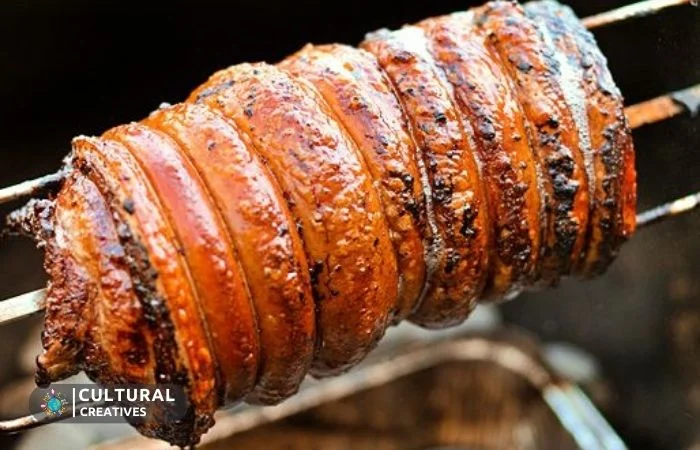
The vivacious spirit of the Philippines shines through its multitude of colorful festivals, and one such event that embodies the joy and heritage of the Filipino people is the Lechon Festival. Celebrated predominantly in the province of Batangas, this festival pays homage to the country’s most beloved festive dish, the lechon – a whole roasted pig known for its crispy skin and succulent meat.
The Origin Of Lechon Festival
The Lechon Festival, locally referred to as ‘Parada ng Lechon’, originated in the town of Balayan on the 24th of June, coinciding with the feast of St. John the Baptist. This yearly event is not merely about indulgence but also ritual and history.
It amalgamates religious observance and communal pride enveloped in a day of feasting, water dousing, and parades.
Celebratory Rituals
- Parade Elegance: The centerpiece of the festival is a parade featuring lavishly decorated lechons. This display parade is not just a feast for the taste buds but also for the eyes as each pig is dressed in elaborate costumes or adorned with intricate designs to showcase local artistry.
- Water Revelry: Mimicking the water baptism of St. John, participants and spectators engage in friendly water fights. Amidst the splashing, the laughter and energy of communal bonding form the heartbeat of the festival.
- Community Feasts: After the parade, the lechons are shared among everyone, creating communal dining experiences that highlight the Filipino spirit of unity and generosity.
Cultural Significance
The Lechon Festival serves as a testament to the deep-rooted sense of community within Filipino culture. It is a gesture of sharing prosperity and celebrating life’s blessings. Beyond mere merrymaking, the festivities underscore the Philippines’ rich culinary traditions and the significant role that food plays in Filipino social life.
A Magnet For Tourism
Not only does the Lechon Festival bring locals together, but it also beckons tourists from across the globe, keen to savor this authentic Filipino experience. Exploring the Lechon Festival is an opportunity for cultural immersion, where international visitors can taste local delicacies, observe traditional customs, and partake in the Filipino way of jubilation.
6. moriones
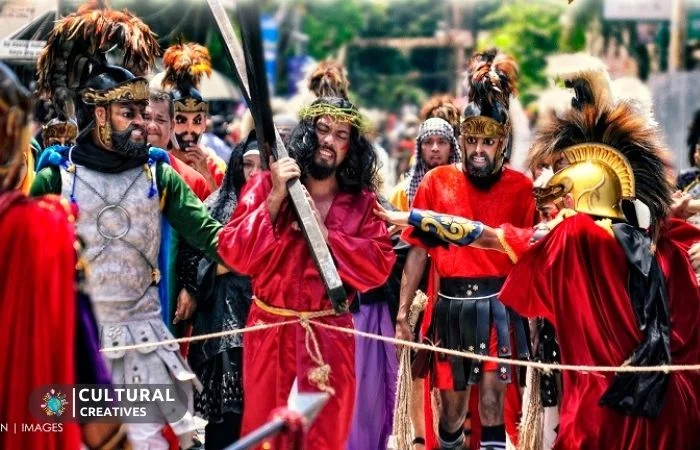
Dive into the culture of the Philippines with the Moriones Festival, an annual spectacle that embodies the passion and creativity of Marinduqueños. Revered as one of the most colorful religious festivals in the Philippines, this week-long celebration during Holy Week brings together a unique mix of culture, history, and artistry.
Origin And History
The roots of this festival run deep into the heart of Marinduque’s history:
- Celebration’s inception: The Moriones Festival traces back to the late 19th century.
- Cultural ties: It intertwines with the narrative of the Roman soldier Longinus.
- Religious significance: It is mainly a reenactment of the life and struggles of Saint Longinus intertwined with the observance of Lent.
Customs And Traditions
The festival is rich in customs that mesmerize onlookers:
- Mask crafting: Local artisans carve out intricate wooden masks, known as ‘morions,’ portraying the faces of Roman soldiers.
- Traditional garb: Participants don vividly colored tunics, helmets, and capes, transforming into biblical soldiers.
- Street performances: Reenactments of biblical scenes unfold, blending spiritual devotion with communal artistry.
Impact On Community
Embracing this festival has significant effects on the locale:
- Economic boost: The influx of tourists provides a healthy surge to local businesses and craftsmen.
- Cultural preservation: It serves as an avenue for passing down traditions and maintaining Marinduque’s cultural identity.
- Social cohesion: The collective effort required to stage the Moriones Festival fosters unity and a sense of pride among the residents.
Unique Highlights
Every year, unique aspects capture the hearts of spectators:
- Centurion’s dance-off: An impromptu showdown often erupts with jesters playfully battling in dance.
- Search for Longinus: A gripping dramatization leads up to the search for the one-eyed centurion, culminating in his eventual encounter with Christ.
- Craftsmanship exhibition: The finesse and diversity of the masks on display showcase the remarkable talent of Marinduque’s artisans.
When To Visit
Timing is everything to experience the festival at its peak:
- Holy Week: Occurring annually, plan your visit during the Lenten season, particularly from Holy Monday to Easter Sunday.
- Best days for spectacles: The most dramatic events and processions happen on Good Friday and Black Saturday.
Tips For Travelers
Make the most of attending the Moriones Festival:
- Accommodation: Book your stay well in advance as places fill up quickly during the festival period.
- Cultural etiquette: Show respect for local customs and religious practices, especially during reenactments.
- Participation: Engage with the festivities; locals appreciate when visitors immerse themselves in the experience.
Leaving A Lasting Impression
The Moriones Festival is a testament to Filipino creativity and faith – a tableau that stays with you long after you’ve left its streets. It’s not just the kaleidoscope of masks or the pulsating drum beats but the palpable spirit of unity and reverence that makes this festival a profound celebration of life and culture.
7. Lanzones
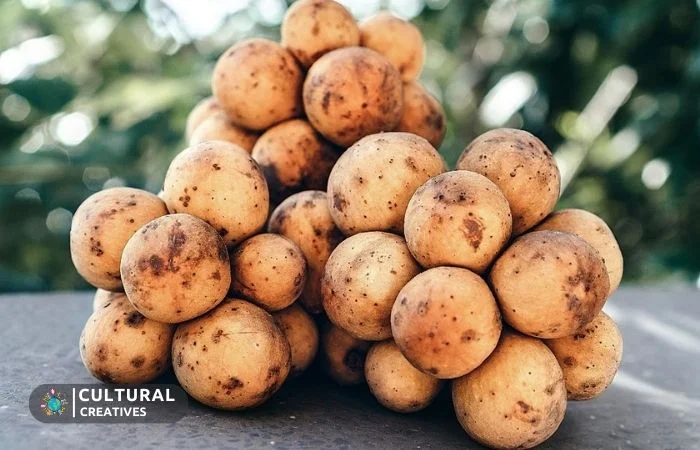
Delving into the heart of Filipino culture, we come across the Lanzones Festival, an annual celebration that paints Camiguin Island with colors and infectious joy. Revered not only for its entertainment value but also as a tribute to the lanzones fruit, this festival is a deep-rooted tradition symbolizing the town’s gratitude for bountiful harvests and prosperity.
Origin And Significance
Bursting onto the scene with historical richness:
- Cultural Roots: The Lanzones Festival owes its beginnings to age-old customs of the indigenous people of Camiguin.
- Thanksgiving: It is a joyous expression of thanks for the lanzones fruit, believed to have been made sweet by a mythical nymph’s enchantment.
Festival Highlights
Camiguin Island turns into a stage as the festival unfolds:
- Street Dancing: Witness the colorful spectacle of locals donning costumes representing lanzones, swaying to the rhythm of folk music.
- Lanzones Pageantry: Glimpse the crowning of the Festival King and Queen, exuding grace, donned in magnificently designed outfits inspired by the sun-kissed lanzones.
Activities For Visitors
The Lanzones Festival is not merely a visual delight; it offers a suite of activities to immerse every visitor in its celebratory spirit.
- Tasting Booths: Tempt your taste buds with sweet, locally-grown lanzones, a tropical fruit cherished for its unique flavor.
- Cultural Shows: Enjoy a medley of performances that encapsulate the island’s history and the significance of the lanzones to its people.
Economic Impact
Economically, the festival marks a pivotal time for the region:
- Boost to Local Business: The influx of tourists translates to increased sales for local artisans and vendors, invigorating the community’s economy.
- Agricultural Promotion: It serves as a prime opportunity to showcase Camiguin’s agricultural pride, the lanzones, garnering interest from both local and international markets.
When To Visit
Timing is everything to experience the festival’s full splendor:
- Peak Season: Usually taking place in October, it aligns with the harvesting period of the lanzones, ensuring the freshest experience.
- Weather Considerations: The ideal weather during this season makes for a comfortable and enjoyable visit to the island.
What To Wear
Dressing right can enhance your festival experience:
- Comfort First: Light, breathable clothing is recommended due to the tropical climate of the Philippines.
- Festive Attire: Embrace the spirit by wearing hues or costumes inspired by local tradition for a more authentic experience.
Travel Tips
Here are some essential tips for those planning to attend the Lanzones Festival:
- Book in Advance: With the festival’s popularity, early accommodation and travel reservations are a must to avoid last-minute hassles.
- Stay Hydrated: Always carry water, as exploring the festival and participating in activities can be dehydrating under the sun.
Joining The Celebrations
Everyone is welcome to join the festivities and partake in the rich cultural heritage that the Lanzones Festival has to offer. Engage with the locals, dive into the cultural events, and make memories that are as sweet as the lanzones themselves.
8. Dinengdeng
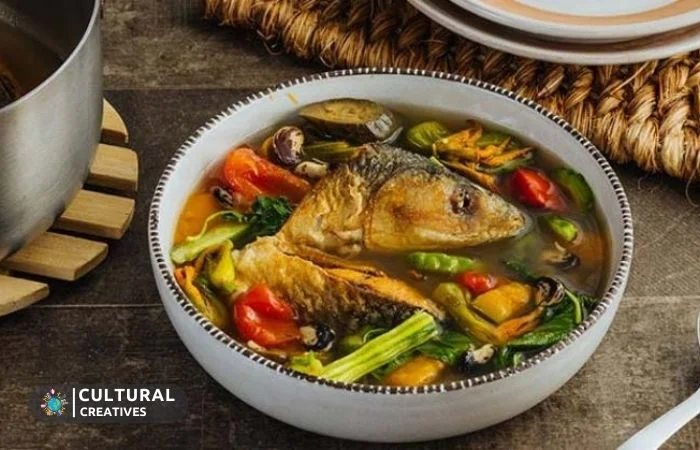
Every corner of the Philippines teems with festivals, each bringing to life the rich tapestry of culture and tradition that defines the archipelago. The Dinengdeng Festival is a mouthwatering celebration that pays homage to the culinary prowess of its people and their beloved dish, Dinengdeng.
What Is Dinengdeng?
- Originating from Ilocano culture: Dinengdeng is a flavorful vegetable stew that is a staple in the Ilocano diet, reflecting the community’s close ties with agriculture and their ingenuity in utilizing local ingredients.
- Main ingredients: A mix of indigenous vegetables, grilled fish, and fermented fish sauce (bagoong isda) lends this dish its unique taste and nutritional value, showcasing an authentic local culinary experience.
The Heartbeat Of Ilocos Norte
Traditionally held in May, this festival is not only a food lover’s paradise but a display of Ilocano heritage. It brings people from all walks of life together in a colorful celebration. As you wander through the streets, your senses are enveloped in the warm and inviting aromas of Dinengdeng cooking competitions, a highlight that lures in both locals and tourists alike.
Experience Dinengdeng In All Its Glory
- Cooking competitions: Aspiring chefs and home cooks showcase their culinary skills, vying to create the most delectable version of Dinengdeng.
- Cultural presentations: Interpretive dances and music envelop the festivities, painting a lively picture of Ilocano history and its intimate connection with agriculture.
Feasting on various recipes of Dinengdeng is a treat to the palate, and it highlights the region’s bountiful produce. The dynamics of the festival encapsulate a sense of community, serving as the perfect opportunity for visitors to dive into the essence of Ilocos Norte’s local life and traditions.
Each simmering pot of Dinengdeng is a story, a piece of heritage, and a celebration of Ilocano culinary artistry.
9. Ammungan

The Ammungan Festival serves as a vivid canvas showcasing the rich tapestry of Nueva Vizcaya’s culture. Every May, locals and tourists alike are treated to a spectacular celebration of unity and tradition that reverberates through the streets and tranquil villages of the province.
Significance Of Ammungan
The Ammungan Festival, originally known as the “Grand Ammungan,” is not just a feast for the eyes; it’s a heartfelt homage to the province’s founding anniversary. It’s a time when the air is thick with joy, and the community’s spirit is as infectious as the rhythmic beats pulsing through the throng of revelers.
A Kaleidoscope Of Activities
- Parades and Street Dancing: Flamboyant costumes and spirited dances paint the town in a riot of colors, reflecting the region’s ethnic diversity.
- Agro-Industrial Fairs: Discover the bounty of Nueva Vizcaya as local produce and crafts take center stage, offering a glimpse into the region’s economic vitality.
- Cultural Shows: Tales of folklore and tradition come alive through performances that captivate and educate, bridging the past with the present.
- Sporting Events: With adrenaline-fueled competitions, witness the embodiment of strength and teamwork within the community.
Cultural Significance
Through the Ammungan Festival, cultural preservation is enacted with every dance step and woven pattern, inviting onlookers to delve into the province’s rich history and customs. It’s an event that fosters pride among the people, reminding them of their shared heritage and the binding ties of their community.
Why You Can’t Miss Ammungan
Take part in the Ammungan Festival and you’ll find more than just a celebration; you’ll experience a living, breathing journey into the soul of Nueva Vizcaya. As laughter and music fill the air, join hands with locals in a dance of unity, taste the flavors of native cuisine, and create memories that will linger long after the festival’s echoes have faded.
Remember, engaging in this festival is more than just observing; it’s about immersing yourself in the life of the region, understanding its heartbeat, and carrying with you the indelible mark of its cultural opulence.
10. Tinagba
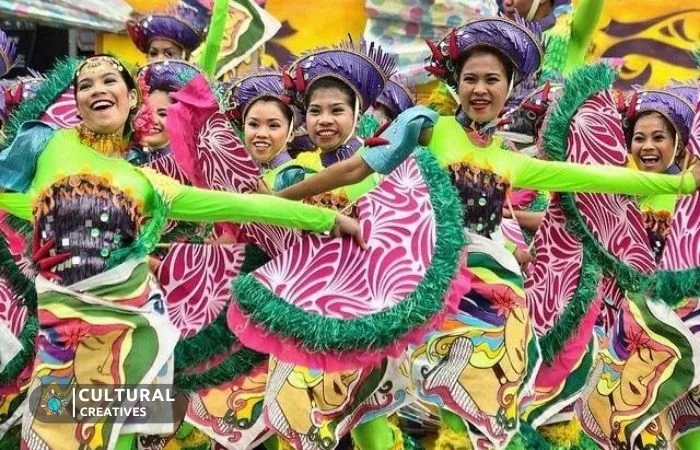
Immerse yourself in the vibrant and colorful celebration of the Tinagba Festival, an annual event steeped in cultural heritage and agricultural tradition. Held in the Bicol Region of the Philippines, this festival is a grand expression of thanksgiving by farmers for a bountiful harvest.
With its street parades, traditional dances, and native costumes, Tinagba showcases the rich tapestry of Filipino customs.
History And Origins
- Roots in Ancient Rituals: The festival has its origins in early pagan rituals where locals would offer the first harvest to their deities as a gesture of gratitude and to secure a prosperous growing season.
- Christian Integration: When Christianity was introduced in the Philippines, these indigenous practices were woven into the Christian faith, resulting in the festival’s present form which honors the Virgin Mary.
Celebratory Activities
The city comes alive with a plethora of activities designed to both entertain and pay homage to their traditions. Visitors and locals alike delight in the various aspects of the festival.
- Street Parades and Floats: Lavish floats carrying beautiful depictions of the bountiful harvest and local folklore make their way through the streets, a visual feast for spectators.
- Cultural Performances: Energetic dancers in radiant, native attire perform to the rhythm of local music, each step and beat telling a story of their heritage and way of life.
Community Involvement
Participation is at the core of the Tinagba Festival, with the entire community coming together to contribute to its success.
- Farmers’ Showcase: Local farmers proudly display their harvests, sharing the fruits of their labor with the community and visitors.
- Competitions and Games: Community members engage in friendly contests and interactive games, fostering a spirit of camaraderie and fun.
Visitor Experience
Soak in the atmosphere of the Tinagba Festival with an open heart and witness the genuine spirit of Philippine culture. This event is not just a feast for the eyes but also a meaningful encounter that weaves together social bonds and historic continuity.
- Immersive Cultural Discovery: Gain insights into the Filipino way of life and their connection with agriculture.
- Festive Treats and Souvenirs: Taste the local delicacies and bring home crafted mementos that capture the essence of the festival.
11. Pahiyas
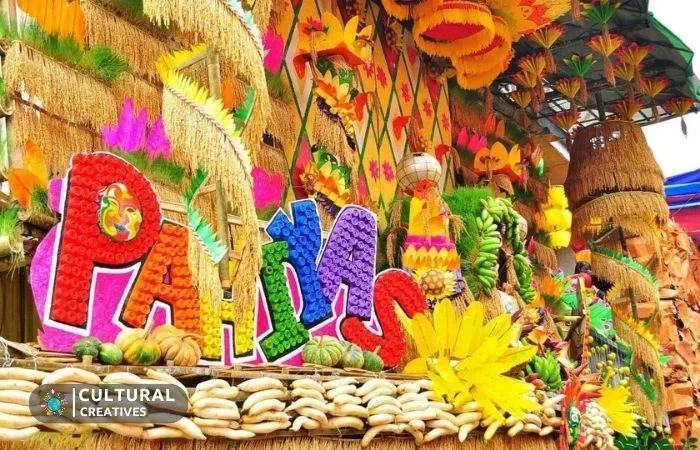
The Pahiyas Festival is one of the most colorful and events in the Philippines. Held annually in Lucban, Quezon, this feast honors San Isidro Labrador, the patron saint of farmers. It’s a thanksgiving celebration for a bountiful harvest, marked by an outpouring of creativity, joyful parades, and a truly festive atmosphere that bathes the town in a spectrum of hues.
Origin And History
- Date of celebration: The Pahiyas Festival is celebrated every 15th of May. This day is chosen in accordance with the feast day of San Isidro Labrador.
- Connection to agriculture: San Isidro is believed to be a protector of the farmers, ensuring plentiful harvests. This festival stands as a tribute to the toil and success of the local agriculture community.
Decorations And Artistry
A striking feature of the Pahiyas Festival is the multitude of decorations that adorn houses and streets. These aren’t your typical ornaments; they’re a blend of religious reverence and an ode to the harvest.
- Kiping: These are leaf-shaped wafers made of rice and dyed in bright colors. They’re arranged in elaborate displays, forming chandeliers or layered to resemble giant flowers.
- Agricultural harvest: Homes are also decorated with a variety of fruits, vegetables, and grains, showcasing the town’s rich harvest and adding an organic touch to the visuals.
Activities And Celebrations
At the heart of the festival are activities that showcase Lucban’s heritage and the community’s unity.
- Parades and street dancing: The streets come alive with parades, featuring local residents dressed in traditional farming attire, accompanied by musicians and dancers.
- Competitions: Homeowners compete to have the most creatively decorated house with kiping and other agricultural products, making the parade routes a stunning sight to behold.
Culinary Delights
What’s a festival without a feast? The Pahiyas Festival serves up an array of local delicacies that are as much a draw as the visual spectacles.
- Lucban Longganisa: This garlic-heavy sausage is a local specialty and a must-try for visitors.
- Pancit Habhab: Taste this unique Filipino noodle dish served on banana leaves, which adds to the rustic, authentic experience.
Cultural Significance
Beyond the merriment, the Pahiyas Festival carries deep cultural significance for the residents of Lucban and the Philippines at large.
- Showcasing Filipino culture: The festival highlights Filipino creativity, resilience, and the strong sense of community that’s emblematic of the nation’s spirit.
- Religious devotion: It is also a testament to the country’s rich religious traditions, blending Catholic beliefs with local customs in a harmonious celebration.
By immersing yourself in the Pahiyas Festival, you take part in a bountiful heritage that’s as nourishing for the soul as the harvest is for the body. It’s an annual reminder of life’s palette and the community harmony that binds the Filipino spirit.
12. Pintados
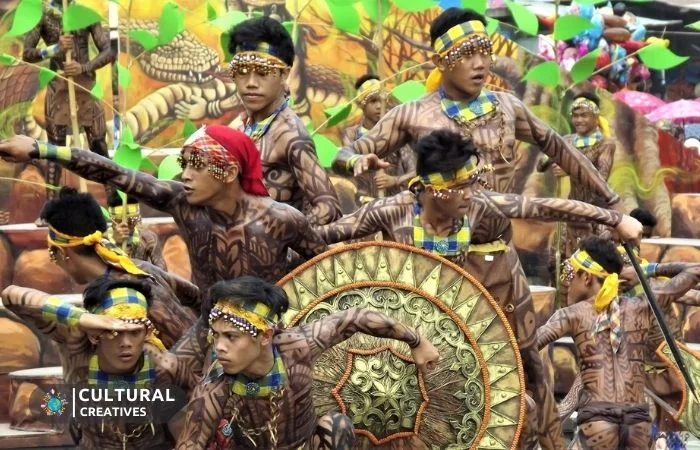
The Pintados Festival is an annual celebration that speaks volumes of the rich history and traditions of the Visayan people in the Philippines. It is more than just a feast for the eyes; it is a journey through the past, narrated through dances, colorful body paintings, and rhythmic beats that echo the spirit of the warriors of old.
Origins And History
- The roots of the festival: Acknowledging the pre-colonial Visayan warriors who were known for their adorned and tattooed bodies, symbolizing bravery and status.
- Time of celebration: The Pintados Festival is traditionally held in June, culminating in a grand parade that transforms the streets into a canvas of ancestral pride and communal joy.
Festival Highlights
To truly appreciate the Pintados Festival, one must immerse in the events that bring it to life. The festival’s highlights are moments when history and culture blend seamlessly, captivating spectators and participants alike.
- Ritual dances: Performers illustrate tales of old, their bodies intricately painted with patterns that mirror those of ancient warriors.
- Traditional games: A throwback to indigenous Filipino sports and activities, evoking a sense of nostalgia and competitive spirit among the attendees.
Cultural Significance
The festival serves as a reminder of the warriors’ courage and the endurance of their descendants. It’s a tribute to the identity of a people whose history is etched not only on their skin but in the collective memory of the nation.
- Preservation of heritage: Through performances and elaborate costumes, the festival acts as a living museum, displaying the rich tapestry of Visayan culture for the world to see and appreciate.
- Educational impact: Serving as a bridge between generations, the festival educates the youth and rekindles the interest in the practices of their ancestors, fostering a deeper understanding of their cultural legacy.
Community Involvement
Every facet of the Pintados Festival is a testament to the collaborative effort and passion of the people. Their investment in the festivities is observable in every drum beat, every brush stroke, and every chant that rises in the air.
- Inclusivity: The community comes together, transcending social barriers, to work hand in hand in preparation for the festivities.
- Economic growth: As the festival draws spectators from across the globe, it helps invigorate the local economy through tourism, crafts, and culinary ventures.
Festive Atmosphere
Expect a sensory overload as the Pintados Festival unfolds. The atmosphere overflows with enthusiasm, and jubilation is infectious, with locals and tourists mingling in an ambiance that can only be described as truly Filipino.
- Street parties: High-energy celebrations fill the streets, where dancing and singing create an unceasing carnival vibe.
- Culinary delights: Tickle your taste buds with regional specialties, each dish telling its own story of the islands and their bountiful harvests.
The Pintados Festival is a gripping narrative written on the canvas of the people’s skin, expressed through their cultural tableau. It’s a periodic reminder that the Philippines is not just an archipelago of islands, but also of narratives that continue to shape its identity.
Embracing the essence of this festival is akin to tracing the footsteps of warriors past—each step a discovery, each beat a legacy preserved.
13. Giant Lantern
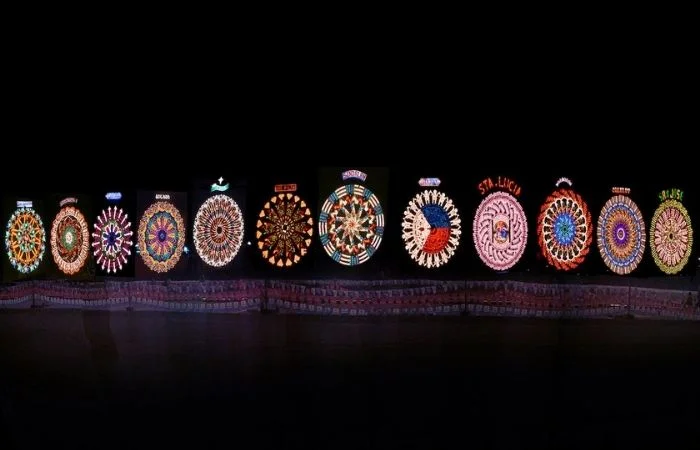
Celebrate the Giant Lantern Festival, a highlight of Philippine festivities showcasing dazzling, kaleidoscopic lights. Annually held in San Fernando, Pampanga, it enthralls spectators with its spectacular display of elaborate, locally crafted lanterns.
A journey through the enchanting festivals in the Philippines, we encounter a spectacle like no other: the Giant Lantern Festival. Known locally as ‘Ligligan Parul’, it displays an electrifying combination of artistry, competition, and community spirit, illuminating the night with radiant Filipino craftsmanship and tradition.
History And Significance
The Giant Lantern Festival has a rich history that dates back to the early 1900s. Originally, these lanterns were simple creations made of papel de Japon (Japanese origami paper) and lit by candlelight. As time progressed, so did the lanterns, evolving into intricate designs showcasing the ingenuity and creativity of the Filipino people.
The festival serves as a stage for friendly competition among local artisans and symbolizes the Star of Bethlehem that guided the Three Kings during the Christmas season.
Participating Barrios And Artisans
- Creativity shines: Each participating barrio, or neighborhood, dedicates countless hours to design and produce a lantern.
- Nurturing talent: The festival acts as a platform for local artisans to display their craftsmanship and innovative use of materials.
- Team effort: Constructing these lanterns is a collaborative process, involving the skills of electricians, painters, and metal workers to bring the designs to life.
Event Highlights
Visitors of the Giant Lantern Festival are treated to a visual symphony where light dances to the tunes of Christmas medleys. As the sun sets, these majestic creations, sometimes towering at around 20 feet in diameter, start their performance to the delight of onlookers.
Each lantern is fitted with thousands of spinning lights, controlled by rotors, creating a kaleidoscope of patterns and colors that captivate audiences and celebrate the Filipino festive spirit.
Cultural Impact
The influence of the Giant Lantern Festival stretches beyond the borders of Pampanga, where it is celebrated. It echoes the deep-seated Filipino value of Bayanihan, denoting community solidarity and cooperation. This festival not only garners national pride but also attracts tourists from around the globe, bolstering the local economy and placing Filipino artistry on the international stage.
Tips For Visitors
- Plan ahead: The festival usually takes place in December, so it’s wise to arrange travel and accommodation in advance to avoid the rush.
- Prime location: Find a strategic spot early for the best view of the lanterns, as crowds can grow quite large.
- Cultural immersion: Engage with the locals to learn more about the stories and the effort put into each lantern, enriching your experience.
Embrace the warm glow of Filipino hospitality as you marvel at the Giant Lantern Festival, a testament to the country’s culture and traditions. This event is not just a feast for the eyes but also a celebration of unity, creativity, and festive joy.
14. Higantes
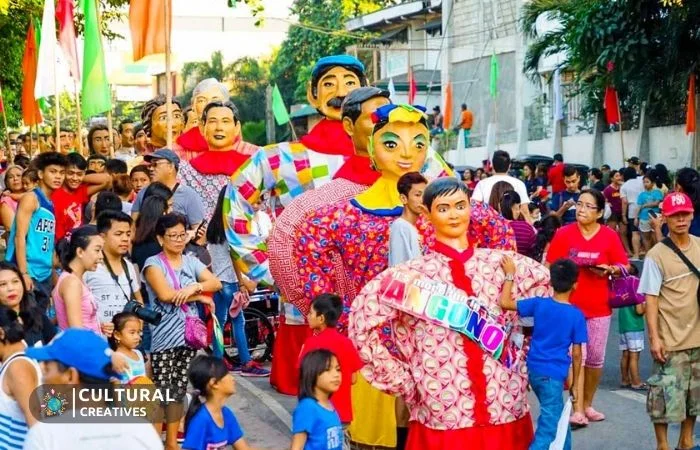
Every November, the streets of Angono, Rizal become a spectacle of giant paper-mache figures during the Higantes Festival. This event, steeped in cultural history, is a feast for the eyes, drawing visitors from across the globe to witness the colossal creations that epitomize Filipino artistic ingenuity and communal spirit.
Origins Of The Festival
- Historical roots: The Higantes Festival traces its history back to the late 1800s, originally a form of protest against Spanish colonizers.
- Patron saint celebration: It has since transformed into a joyous event commemorating San Clemente, the patron saint of fishermen, showcasing the locals’ deep devotion and celebratory customs.
The Higantes Figures
Creating these towering effigies is an art in itself, with local artists pouring their creativity and craftsmanship into every detail. These higantes can reach astounding heights of up to twelve feet, each one uniquely designed to reflect various aspects of community life, from traditional roles to modern-day figures.
Festival Activities
- Street parades: The festival is synonymous with its energetic parades where the higantes, accompanied by music and dancing, take to the streets in a dazzling display.
- Cultural events: A myriad of cultural events, including art exhibits and competitions, amplify the festive mood, fostering a sense of pride in Filipino heritage and culture.
Impact On Tourism
Angono’s Higantes Festival not only serves as a canvas for local traditions but also plays a significant role in boosting tourism. Visitors are treated to a glimpse of the Philippines’ rich cultural tapestry, contributing to the local economy and spreading awareness of the country’s diverse festivities.
Joining The Festivities
If you’re planning to experience the Higantes Festival, be prepared to immerse yourself in a whirlwind of colors, sounds, and cultural splendor. The locals are famously welcoming, inviting guests to partake in the celebrations and create unforgettable memories in the Philippines’ “Art Capital.”
15. Peñafrancia
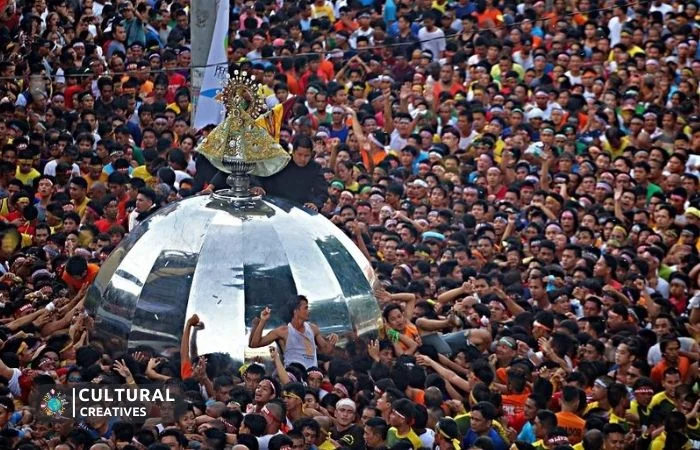
The city of Naga in the Bicol Region of the Philippines pulsates with fervor and devotion as it celebrates the Peñafrancia Festival. Legions of devotees partake in this marian feast honoring Our Lady of Peñafrancia, the patroness of the Bicol Region.
It’s a spiritual ceremony meshed with cultural fanfare, exhibiting the colorful tapestry of Filipino faith and tradition.
Origin And History
- Foundation: The Peñafrancia Festival dates back to 1710 when a local devotee named Miguel Robles de Covarrubias initiated the Marian devotion.
- Inspiration: The festival was inspired by the devotion to Our Lady of Peñafrancia in Salamanca, Spain, echoing the Spanish influence on Filipino culture.
Main Events Of The Festival
Engaging festivities envelope Naga City during the Peñafrancia Festival, entwining spiritual observance with jubilant celebrations. Here’s what makes the festival so captivating:
- Fluvial Procession: A staunchly attended river parade where the image of the Virgin is carried on a decorated barge along the Bicol River.
- Voyadores Festival: A street dance in honor of the trial bearers, where dancers perform routines to the rhythmic beating of drums.
Cultural Significance
Every rhythmic beat and heartfelt prayer during the Peñafrancia Festival encapsulates the essence of Filipino heritage. This event is not merely a religious observance but a milestone that deeply influences the cultural landscape of the region, strengthening the community bonds and showcasing the resilience and fervor of the Filipino spirit.
Tips For Festival Goers
For an immersive experience at the Peñafrancia Festival, consider these handy tips:
- Plan ahead: Accommodations can fill up quickly, so book your stay well in advance to secure a spot close to festival activities.
- Respect traditions: While the festival is a time of joy, it remains a religious event. Visitors are encouraged to participate with reverence and respect for local customs.
16. Tnalak

In the heart of South Cotabato, Philippines, the Tnalak Festival unravels as an exuberant celebration marked with colors, rhythmic dances, and a deep reverence for cultural heritage. Annually observed in July, this festival is a homage to the indigenous T’boli people’s age-old tradition of weaving Tnalak cloth, a material that’s not just fabric but a symbol of life and identity for the T’boli tribe.
Core Elements Of The Tnalak Festival
The Tnalak Festival is a multi-layered event with several core components that provide festival-goers with a full-bodied cultural experience. It’s an immersive journey through the rich tapestry of the region’s ethos:
- Dream Weavers: T’boli women, known as the dream weavers, are celebrated for their unique skill in crafting the Tnalak cloth, which is believed to be patterned after designs revealed to them in dreams.
- Colorful Parades: These processionals display elaborate costumes and props, illustrating the striking patterns of Tnalak textiles.
- Community Involvement: A beautiful aspect of the festival is the communal collaboration, fostering unity as locals work together to put on a spectacular event.
Experience The Tnalak Festival
When visitors plunge into the festivities, they’re met with an experience that delights the senses. From savory street food to the intricate dances performed by the locals, the Tnalak Festival is a feast for the eyes, ears, and soul:
- Cultural Competitions: Dance contests and pageants are a staple, highlighting the artistic expression connected to the T’boli culture.
- Local Delicacies: The variety of traditional Filipino street food available is remarkable, offering an array of tastes and textures unique to the region.
- Handicraft Markets: Exploring the markets, visitors can witness the exquisiteness of Tnalak weaving up close and purchase handcrafted souvenirs to keep the memory of the festival alive long after they depart.
Significance Of Tnalak Fabric
Delving deeper into the festival’s heart, one cannot overlook the importance of the Tnalak fabric. It’s not merely a textile; it serves as the festival’s soul, encapsulating ancestral narratives and spiritual beliefs:
- Symbolism: Each Tnalak pattern carries depth, often symbolizing elements of nature, the tribe’s vision of the cosmos, or life events.
- Prestige and Rituals: Tnalak is not just an everyday fabric; it is used in important ceremonies and as a cherished gift, indicative of respect and honor.
- Heritage Preservation: The festival, through its focus on traditional weaving, plays a crucial role in preserving the T’boli’s unique cultural artifacts for future generations.
Joining The Celebration
For anyone looking to partake in the Tnalak Festival, the experience is enriching and multifaceted. It’s a chance to witness a community’s devotion to their ancestral crafts and to participate in an event where the past and present are woven together seamlessly:
- Plan Ahead: Secure accommodations and festival itineraries well in advance, as the event draws attendees from across the globe.
- Respectful Participation: Immersing oneself in the celebration respectfully acknowledges the cultural significance of the T’boli people’s practices and customs.
The Tnalak Festival, with its celebration and deep cultural roots, invites everyone to partake in a living tradition. This event is a compelling showcase of the Philippines’ diverse cultural landscape, revealing the threads that connect us to history, community, and the artistry that defines human experience.
17. Sandugo
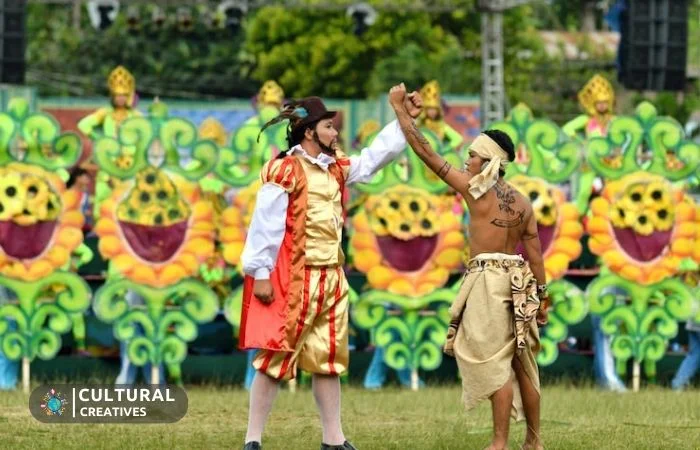
The Sandugo Festival is a cultural celebration in the Philippines, commemorating the historic blood compact between Datu Sikatuna and Spanish explorer Miguel López de Legazpi. This annual event in Bohol showcases street dancing, colorful costumes, and rich Filipino heritage.
Every July, the province of Bohol in the Philippines bursts into a spectacle of culture and history through the Sandugo Festival. This event commemorates the Treaty of Friendship between the Spanish explorer, Miguel López de Legazpi, and Datu Sikatuna, a native chieftain.
Locals and tourists alike immerse themselves in a celebration that’s both a visual feast and a tribute to a pivotal moment in the country’s past.
Historical Significance Of The Sandugo Festival
The Sandugo Festival has deep historical roots connected to early diplomatic relations in the Philippines:
- The Blood Compact: A traditional blood brotherhood pact was formed in 1565 to ensure peace and cooperation between the Spaniards and the Boholanos.
- Recognition of Friendship: The festival honors one of the first treaties of friendship between the Europeans and the indigenous people of the Philippine archipelago.
These elements of peace and camaraderie are what fuel the Sandugo Festival’s essence, reflecting a unique blend of culture that has survived through the centuries.
Modern Celebrations
The contemporary celebrations of the Sandugo Festival are a grand showcase of local customs and communal spirit:
- Street Dancing Competitions: Vibrantly costumed dancers bring tales of history and folklore to life, recounting the Sandugo story through choreographed movements and rhythmic beats.
- Cultural Events and Exhibits: Art exhibitions, traditional crafting demonstrations, and cultural shows provide a window into Bohol’s rich artistic heritage.
Amidst these lively festivities, the festival also serves as a way to preserve traditions and captivate audiences with the story of unity and friendship, a narrative just as relevant today as it was centuries ago. With a mindful adherence to the principles of EAT (Expertise, Authoritativeness, and Trustworthiness), content about such a rich cultural event echoes authenticity and ensures it resonates with a global audience seeking genuine experiences.
18. Lang Ay
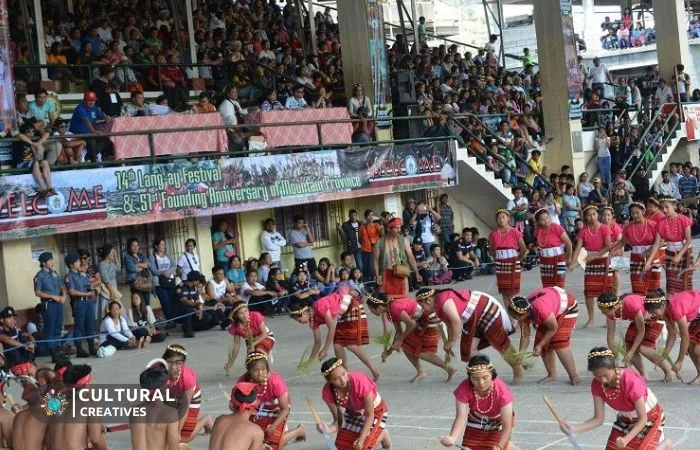
The Lang Ay Festival is one of the most distinct and cultural celebrations in the Mountain Province of the Philippines. This event, held annually in April, is not just a feast for the eyes with its kaleidoscope of traditional attire and lively performances, but it also serves as a profound tribute to the region’s rich heritage and unyielding community spirit.
Celebrating Cordillera Culture
- Representation of tribes: The festival brings together the different tribes of the Cordillera region, each showcasing their unique traditions, dances, music, and crafts.
- Communal unity: Lang Ay is more than a celebration; it’s a symbol of unity and peace among the tribes, who gather to reinforce their bond and shared identity.
The Events At Lang Ay Festival
The festival’s agenda is teeming with activities that cater to a diverse audience, from the curious traveler to the history aficionado. These events are crafted to portray the dynamism of Cordilleran culture and the locals’ way of life.
- Traditional dance performances: Attendees are treated to spectacular dance numbers, with participants donning colorful woven costumes that echo their ancestral roots.
- Agricultural showcases: Reflecting their deep connection with the land, farmers exhibit their most bountiful harvests and agricultural prowess, which has been passed down through generations.
What To Expect When Attending Lang Ay Festival
Visiting the Lang Ay Festival is nothing short of an immersive educational journey. You’ll feel the pulse of the Philippines’ indigenous past and its continuous influence on the present and future.
- Cultural immersion: From the chants and stomps of tribal dances to the intricate handiwork of local artisans, every aspect of the festival invites visitors to dive into the Cordilleran way of life.
- Culinary delights: A banquet of local Filipino delicacies await, giving you a taste of the region’s culinary heritage that’s just as rich as its cultural tapestry.
19. Kadagayaan
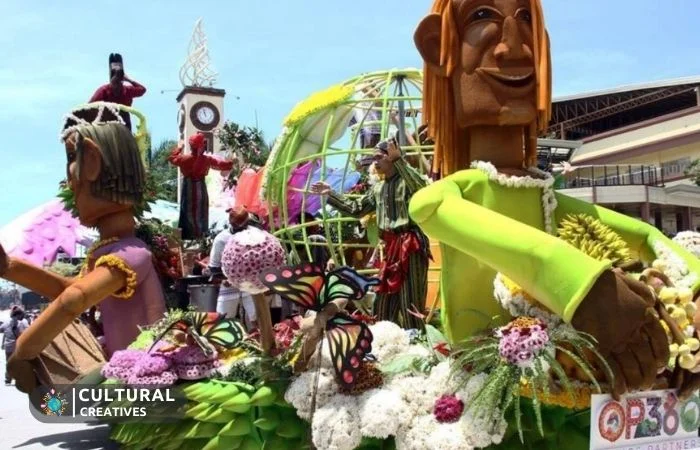
The Kadagayaan Festival bursts onto the streets of Davao every year, mirroring the region’s bountiful harvests and rich cultural heritage. This festivity is a source of pride for locals and a spectacular experience for visitors from all corners of the globe.
What To Expect
- Colorful Street Dancing: The streets come alive with dancers donned in elaborate costumes, their movements telling stories of tradition and prosperity.
- Local Delicacies: Prepare your taste buds for an explosion of flavors, as the festival showcases the best of local cuisine, with each bite reflecting the area’s agricultural wealth.
The Significance Of Kadagayaan
The Kadagayaan Festival isn’t merely a display of cultural exuberance; it’s a deeply rooted celebration that honors the agricultural success of the Davao region. It’s a tribute to the hardworking farmers and a time when the entire community shares joy and gratitude for the year’s blessings.
Activities And Events
Engage yourself in a plethora of activities that include:
- Agricultural Fairs: Discover the region’s top produce and innovative farming techniques that underscore Mindanao’s agricultural prowess.
- Competitions: Get swept up in the excitement of various contests ranging from dance showdowns to sporty endeavors, each adding to the festival’s dynamic atmosphere.
The Community’s Role
Everyone in Davao takes part, with roles that transform the festival into a seamless tableau of jubilation. From organizers to performers, and the warm spectators – the sense of community is undeniable. Kadagayaan beckons everyone to indulge in its festive spirit, reinforcing the bond between the land and its people.
Tips For Visitors
To maximize your festival experience:
- Plan Ahead: Accommodations fill up fast, so book early to ensure a comfortable stay during the festivities.
- Stay Hydrated: The revelry might be intoxicating, but don’t neglect your health — keep water on hand and stay refreshed under the tropical sun.
Preserving Tradition
The festival serves as a living museum, a canvas preserving age-old customs and folklore. Each performance, craft, and local dish represents a thread in the intricate tapestry of Davao’s cultural identity, safeguarded and celebrated through the joyous manifestation of the Kadagayaan Festival.
20. Pamaypay
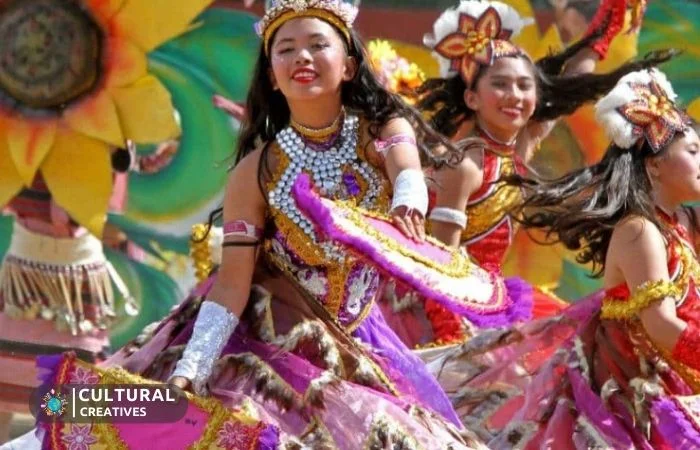
Each year, the town of Paranaque bursts into a kaleidoscope of colors and movement with the Pamaypay Festival. This event celebrates the gentle artistry and cultural significance of the fan, or ‘pamaypay’ in Filipino. Dancers sway to folk melodies, fanning the air with beautifully decorated pamaypays, creating a sight that’s as elegant as it is energetic.
The Origin And Significance
- Historical Roots: The Pamaypay Festival draws inspiration from the Spanish colonial period when the use of fans became widespread in the Philippines. Fans were not merely tools for cooling but symbols of social status and fashion.
- Cultural Representation: Fans, or pamaypays, epitomize the blend of indigenous Filipino traditions and the influences from centuries of trade and colonialism. This festival serves as a homage to this cultural fusion, celebrating local heritage and community spirit.
What To Expect At The Pamaypay Festival
Imagine streets lined with food stalls and the air filled with joyous beats as vibrantly attired dancers perform with their pamaypays. Visitors are treated to a visual feast as performers incorporate fans into traditional Filipino dances, showcasing creativity and skilled craftsmanship.
Joining The Festivities
- Participation: No one’s left behind; locals and tourists alike are encouraged to dive into the merrymaking. Whether dancing or simply clapping along, your presence breathes more life to the festival.
- Workshops and Souvenirs: Take home a piece of the festival by joining fan-making workshops or purchasing a pamaypay from local artisans. These fans serve as both memorabilia and a nod to the Philippines’ rich artistic heritage.
Sustainability And Community Impact
The Pamaypay Festival isn’t just about celebration; it’s a conscientious event that raises awareness about sustainable practices in art and culture. By using eco-friendly materials and promoting local craftsmanship, the festival echoes the community’s commitment to a greener future and support for homegrown talent.
Tips For The Best Festival Experience
Come ready to immerse yourself in tradition, and don’t forget these handy tips:
- Comfortable Attire: The Philippines is tropical; dress in light clothing to best enjoy the day.
- Stay Hydrated: Always have a bottle of water at hand—celebrating is thirsty work!
- Charge Your Devices: You’ll want to capture every moment, so ensure your cameras and phones are ready.
Embrace the beat, the art, and the unity of the Pamaypay Festival – a true testament to the vibrancy of Philippine culture.
21. Balangay

Steeped in history and tradition, the Balangay Festival is a captivating event that celebrates the rich cultural heritage of Butuan City. It pays homage to the ancient Balangay boats that are an intrinsic part of the city’s identity and history, symbolizing unity and cooperation among the early inhabitants.
History And Significance
- Ancient maritime heritage: The festival reflects the city’s recognition of the Balangay boats, which were used by early Butuanons for trade and transport across the Southeast Asian archipelago.
- Tribute to the ancestors: It’s a time to honor the prowess and seamanship of the ancestors who navigated the seas and established Butuan as a significant trading hub in pre-colonial Philippines.
Key Events During The Festival
Dance and music fill the air as the festivities of Balangay unfold. The following are central attractions:
- Colorful boat racing: Showcasing the prowess of modern-day locals, participants race in boats that cue from the design of traditional Balangay boats.
- Cultural performances: Dancers and musicians come together to perform pieces that tell the story of Butuan’s maritime legacy and its impact on the region’s growth and development.
Engaging The Community
The festival is more than just a display of Butuan’s past—it’s an active and engaging affair that:
- Invites participation: During the festival, workshops and activities are set up that encourage visitors and locals to learn about traditional boat-making and navigation techniques.
- Promotes unity: It underpins the values of cooperation and unity, as residents work hand in hand to celebrate and preserve their shared cultural identity.
The Impact On Tourism
Butuan’s commitment to preserving its history:
- Boosting local economy: The festival draws in tourists from across the globe, contributing to the local economy and putting Butuan on the map as a destination for cultural tourism.
- Educational experience: Visitors leave with a deeper understanding of Philippine history and the crucial role that Butuan played in shaping the cultural landscape of the country.
The Balangay Festival is a spirited commemoration packed with activities that provide a deeper appreciation of Philippine history and culture. With each passing year, the event continues to weave the story of the Butuan people and the ancient vessels that are a testament to their enduring legacy.
22. Singkaban
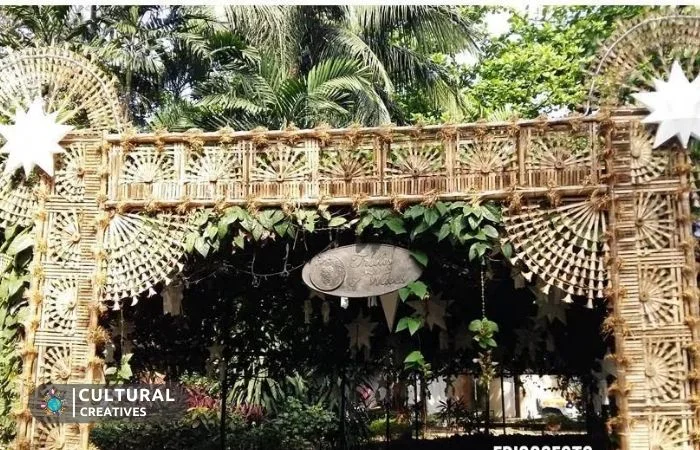
Each year, the province of Bulacan in the Philippines bursts into a kaleidoscope of colors, culture, and artistry with the Singkaban Festival. A reflection of the province’s rich heritage and craftsmanship, the event is named after the traditional bamboo art known as ‘singkaban.
Origins And Significance
- Cultural Roots: The festival is deeply rooted in Bulacan’s history, showcasing a blend of indigenous Filipino culture and Spanish influences.
- Artistic Celebration: Singkaban Festival serves as a stage for local artists to display their bamboo art installations, which symbolize the gates to Bulacan’s towns and cities.
Event Highlights
The air fills with excitement as the Singkaban Festival brings a plethora of activities that captivate both locals and tourists. Street dances, adorned with elaborate bamboo arches, become the canvas upon which the story of Bulacan unfolds in an explosion of movement and rhythm.
Traditions And Activities
- Street Dancing: Energetic dancers don vivid costumes, their performances narrating the history and folklore of the province.
- Bamboo Craft Exhibits: Artisans expertly weave bamboo, creating intricate masterpieces that are both functional and decorative.
When And Where
Mark your calendars for a mid-September adventure in the heart of Bulacan, where the Singkaban Festival is in full swing, usually coinciding with the province’s founding anniversary celebrations.
Why You Can’t Miss It
- Unique Cultural Experience: Engaging in the Singkaban Festival offers an authentic taste of Filipino heritage and its seamless blend with modern festivities.
- Photographer’s Haven: Each corner presents a visually stunning opportunity for photographers to capture the essence of Filipino artistry and celebration.
23. Dinagyang

Immerse yourself in the hues and rhythmic drumbeats of the Dinagyang Festival. Held annually in Iloilo City, Philippines, this event bursts into life with a kaleidoscope of festivity, honoring the Santo Niño (Holy Child Jesus). Every fourth Sunday of January, the streets fill with dancers donning elaborate costumes, their bodies painted in an array of patterns.
Spectators from across the globe are beckoned to witness this extraordinary symphony of devotion and fun.
The Roots Of Dinagyang
- Historical Significance: Commemorates the arrival of Malay settlers in Panay who were then converted to Christianity.
- Religious Tribute: A grand expression of thanksgiving to the Santo Niño, merging Catholic traditions with indigenous Aeta culture.
Drawing on age-old stories, the Dinagyang Festival commemorates the profound transformation of the region’s history, where culture and religion harmoniously intertwine. It’s a visual storytelling masterpiece that transcends mere entertainment.
Highlights Of The Festival
- Ati-Atihan Competition: A spirited contest where tribes compete, presenting choreographed dances and live music.
- Street Parties: An eruption of spontaneous joy as locals and visitors dance together, united by the energy of the festival.
Step into a whirlwind of excitement at the Dinagyang Festival, where the vibrancy of the streets rivals the most colorful of palettes. It’s a unique blend of competition and camaraderie, underscored by the relentless drumbeats that invite everyone to join the dance.
A Feast For The Senses
Witness the festival’s multi-sensory spectacle:
- Visual Extravaganza: Dazzling costumes and street displays captivate the eyes.
- Auditory Delight: The constant drum rolls and music enliven the atmosphere, encapsulating the high-spirited nature of Iloilo.
The Dinagyang Festival is an all-encompassing feast, tantalizing the senses at every turn. It’s an experience that stays with you, long after the last echo of the drums has faded.
Joining The Festivities
- Plan Ahead: Book accommodations and flights early due to high demand.
- Local Etiquette: Be respectful of cultural norms and participate in a mindful manner.
Being a part of this grand event requires some foresight, as the excitement draws in a large number of participants. Navigate the festive chaos with a blend of anticipation and respect. If you’re a returning aficionado or a curious first-timer, the Dinagyang Festival awaits to enchant you with its spectacular ceremonies and infectious zest for life.
24. Rodeo
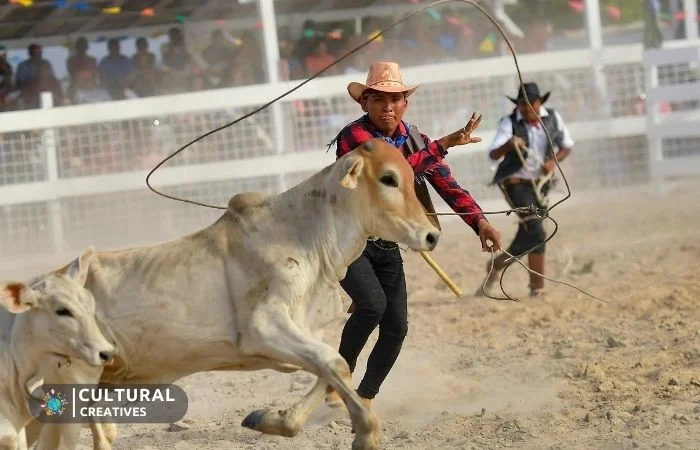
Experience the Rodeo Festival, a thrilling celebration deep in the heart of the Philippines’ Masbate province. Cowboys showcase their skills in lively competitions, encapsulating the unique fusion of Filipino hospitality and Western rodeo traditions.
Philippines’ festivals are a tapestry of culture, each one bursting with color, life, and history. Among them stands the Rodeo Festival, an event that captures the spirit of the Filipino cowboy and pays homage to the cattle-ranching traditions of Masbate.
As the hooves thunder and the crowds cheer, let’s saddle up to explore what makes the Rodeo Festival a unique and unforgettable spectacle.
History And Significance
Steeped in the heritage of the Wild West, the Rodeo Festival is not merely a showcase of skills but a celebration deeply rooted in Masbate’s identity. Originating in the early 1990s, this event has become synonymous with the island’s cowboy culture, setting itself apart from other Philippine festivals:
- Historical origins: The festival traces its beginnings to the introduction of cattle-raising in Masbate, reflecting an intersection of local customs and American cowboy influences.
- Cultural impact: Embraced by the community, the festival honors the rugged life of ranchers and cowhands, becoming a source of local pride and a tool for preserving their unique way of life.
Rodeo Festival Activities
Every April, the Rodeo Festival gallops into action, transforming Masbate into a hub of excitement. The event’s lineup is a thrilling combination of competitive sportsmanship and cultural exhibitions:
- Bull riding: Brave cowboys test their mettle, aiming to stay atop bucking bulls for the longest time.
- Cattle wrestling: Teams compete in a display of strength and strategy, wrestling cattle to the ground with speed and precision.
What Visitors Can Expect
For those embarking on the Rodeo Festival journey, there awaits an experience rife with adventure and cultural discovery.
- Immersive atmosphere: The festival’s atmosphere is electrifying, with live country music, street dancing, and displays of horsemanship creating an immersive Wild West experience in the heart of the Philippines.
- Local flair: From authentic cowboy gear to delicacies like barbecued meats and local treats, the Rodeo Festival offers a taste of Masbate’s ranch life with a distinct Filipino twist.
Tips For Enjoying The Rodeo Festival
If you’re planning to join the Rodeo Festival, here are some insider tips to ensure you have a rootin’-tootin’ time:
- Attire recommendations: Don your best cowboy boots and hat to blend in with the locals and protect yourself from the sun during outdoor events.
- Stay safe: While rodeos are thrilling, they can also be dangerous; ensure that you watch from a safe distance and follow any safety guidelines provided.
25. Capiztahan

Discover the Capiztahan Festival, a spectacle that paints the province of Capiz with its rich cultural tapestry and jubilant celebrations. Every April, the festival springs into action, showcasing the unique heritage and traditions of the people of Capiz. It’s a dazzling display of color, dance, and music that honors the province’s history and its bounty of seafood, primarily known as the “Seafood Capital of the Philippines”.
History And Significance
- Origins of Capiztahan: Capiztahan traces its roots back to the foundation of Capiz province. It marks the anniversary with a grand celebration that embodies the spirit and resilience of its people.
- Purpose of the Festival: The festival serves as a platform to promote the cultural identity and the local industries of Capiz. It’s a manifestation of unity and pride among the Capiceños.
Major Events
Capiztahan Festival is teeming with activities that cater to all age groups and interests. Let’s dive into some of the major events:
- Ati-Atihan Street Dancing: A rhythmic, colorful parade where participants dress in traditional costumes and dance to the beat of indigenous music in honor of the Santo Niño.
- Seafood Festival: An incredible feast showcasing Capiz’s fresh and diverse seafood, from luscious shrimps to the most sumptuous crabs, all cooked in a myriad of styles.
- Fluvial Parade: A river procession thanking the patron saint for blessings received, featuring ornately decorated boats gliding gracefully along the Panay River.
Cultural Significance
The Capiztahan Festival is more than just a series of events; it is a reflection of the province’s soul. Each performance, art piece, and ritual is a story told through the voices and hands of the locals. Embracing the culture, the festival exemplifies the beauty of Filipino community and its enduring traditions, weaving together past narratives with contemporary aspirations.
Tips For Festival-goers
Attending Capiztahan is a thrilling adventure, and to make the most of it:
- Plan and Book Early: Accommodations fill up quickly, and preparing your itinerary beforehand ensures a seamless festival experience.
- Respect Local Customs: Engage with the culture respectfully. Take the opportunity to learn from the community and participate meaningfully in the festivities.
- Stay Hydrated and Protected: The Philippine sun can be intense; always carry water, apply sunscreen, and have protective gear such as hats and sunglasses.
Immerse yourself in the celebratory heart of the Capiztahan Festival, where each beat of the drum and splash of vivid color tells the story of Capiz and its people. It’s a mesmerizing blend of the past and present, inviting everyone to partake in the joy and splendor of Filipino festivity.
26. Magayon
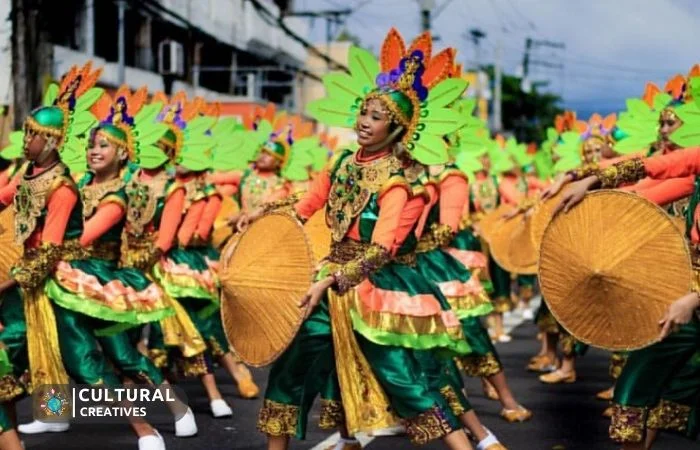
The Magayon Festival erupts with the same splendor as the iconic Mayon Volcano it is named after. This annual spectacle is a celebration of culture, arts, and the legendary tales wrapped around this majestic natural wonder.
Translating to “beautiful” in the local dialect, Magayon Festival does justice to its namesake by showcasing the region’s rich heritage and traditions.
Origins Of Magayon
- Historical Roots: The festival pays tribute to the ancient love story of Princess Magayon, the legend that gives the Mayon Volcano its name.
- Cultural Significance: It’s a time when the locals honor the fertile land and bountiful harvests provided by the surrounding landscapes, particularly the volcano itself.
Celebratory Activities
Enjoy a tapestry of events that fill the festival. The streets come alive with color, from street parades featuring local dancers in traditional garb to the pulsating beats of indigenous music.
- Exhibitions and Contests: Art exhibits, agricultural shows, and cooking competitions highlight Bicol’s local talent and cuisine.
- Beauty Pageant: A highlight is the crowning of the festival’s own Magayon, a young woman who embodies the grace and beauty of the legendary princess.
Impact On Tourism
During this time, Albay becomes a hub of excitement, drawing in visitors from across the globe. The spirit of celebration extends beyond the festivities, offering a boost to local businesses and artisans.
- Economic Growth: The influx of tourists brings valuable revenue to the region.
- Cultural Exchange: Visitors leave with a deeper understanding and appreciation for Bicolano customs and way of life.
When To Visit
Planning a trip to Albay during the Magayon Festival? Aim for the month of May. This period allows travelers to experience everything the event has to offer, under typically sunny skies perfect for outdoor festivities.
Tips For First-time Goers
Navigating the festival can be as exciting as it is daunting. Here are a few pointers to help you make the most out of your experience:
- Accommodation: Book your stay well in advance to avoid the last-minute rush.
- Local Etiquette: Immerse yourself fully, but always show respect for the local culture and traditions.
The Magayon Festival is not only a feast for the eyes but also a testament to the enduring stories and traditions that define the Bicolano spirit. Its tapestry of events offers a memorable experience that resonates with the essence of festivals in the Philippines – unity, history, and an unbridled celebration of life.
Top 5 Non Religious Festivals in the Philippines
27. kadayawan
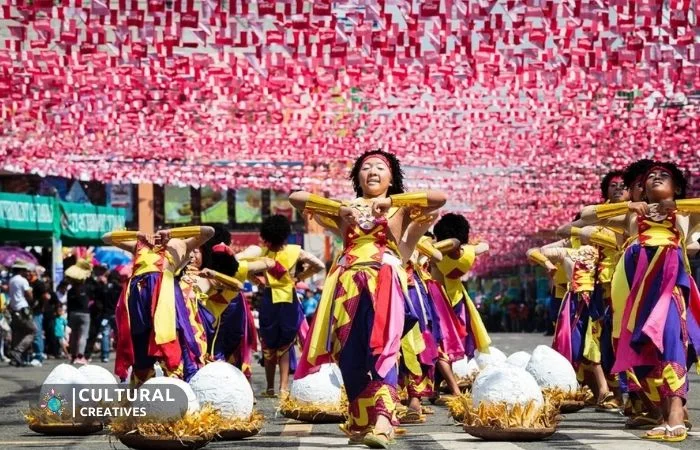
Explore the Kadayawan Festival, a premier Filipino celebration showcasing Davao’s rich culture and bounteous harvests. Revel in its colorful street dances, local delicacies, and floral floats that embody the festive spirit of the Philippines.
The Philippines, with its rich tapestry of culture and tradition, comes alive in the celebration known as the Kadayawan Festival. Held annually in Davao City, this festival is a week-long thanksgiving event that fills the streets with color and jubilation.
It’s a sensory spectacle that beautifully showcases the customs of the indigenous people and the bounties of the region’s harvest.
Celebration Highlights
The Kadayawan Festival is not just a single event but an assortment of activities. Let me highlight a few:
- Street dancing competition: A showcase of colorful costumes and energetic dance moves, accompanied by the rhythmic beats of percussive music.
- Floral floats parade: Staggering displays of artistry and craftsmanship, featuring floats adorned with fresh blooms and produce.
- Traditional games and performances: A chance to witness the strength and skill of local athletes and the compelling beauty of indigenous music and dance.
Significance Of The Festival
The festival’s cultural significance goes beyond mere festivity. It serves as an avenue for the indigenous communities to celebrate their heritage and practices while fostering understanding and respect among the residents of Davao. The Kadayawan Festival thus acts as a bridge that connects the city’s past to its modern-day ethos and values.
Tourism And Local Economy Impact
Economically, the Kadayawan Festival spells prosperity for Davao City:
- Tourist influx: During festival time, tourists, both local and international, flock to the city, leading to a significant boost in the hospitality and service sectors.
- Promotion of local products: The event is a platform for small businesses and artisans to showcase their products, amplifying their reach and increasing sales.
Responsible Participation
When you immerse yourself in the Kadayawan festivities, it’s important to participate responsibly:
- Respect traditions: Engage with the culture in a way that is mindful of the deep-seated traditions and values of the indigenous peoples.
- Environmental impact: Be conscious of your environmental footprint, ensuring that the beauty of Davao is preserved for generations to come.
The Kadayawan Festival encapsulates the spirit and resilience of the people of Davao. It’s an embodiment of their collective identity and a testament to their unwavering spirit of community and cooperation. Witnessing this festival is an experience like no other, and it highlights the unique charm that the Philippines has to offer the world.
28. Panagbenga
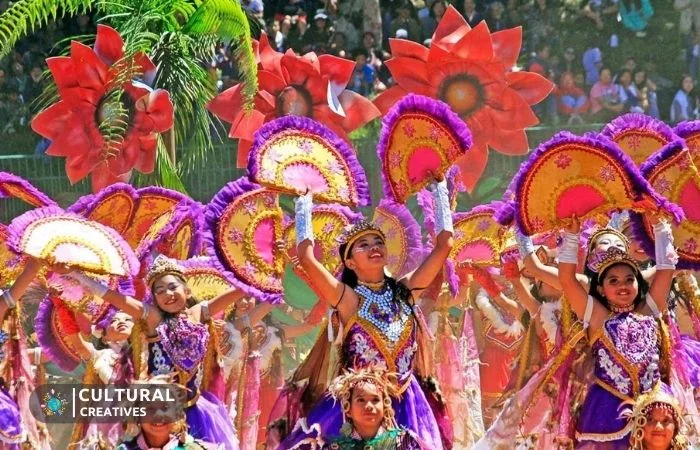
The Panagbenga non religious festivals in the Philippines, a celebration of floral grandeur, lights up Baguio City. Locals and tourists alike revel in the floral floats, street dancing, and garden exhibits that epitomize the region’s rich culture and blooming flora.
The History Behind The Festival
- Origin of the name: ‘Panagbenga’ comes from a Kankanaey term meaning ‘a season of blooming’. This festival is more than just a showcase of flowers; it represents the resilience and rejuvenation of Baguio’s communities.
- Commemoration: The Panagbenga Festival honors the city’s recovery following a natural disaster. It’s a testament to the spirit of the people, expressing their cultural heritage and a collective desire for growth and prosperity.
Highlights Of Panagbenga
Expect the city streets to be adorned with floral floats and parade participants wearing flower-inspired costumes. Here’s what captivates visitors:
- Grand Street Dancing Parade: Vibrant and rhythm-filled, the streets become a stage for multicolored performances depicting local stories and traditions.
- Grand Float Parade: An awe-inspiring spectacle, decorated with a vast array of flowers, these floats showcase the creativity and craftsmanship of local artists.
Cultural Significance
At its core, Panagbenga is a deep-rooted cultural affair:
- Community involvement: It’s a collaborative effort where schools, businesses, and residents come together to prepare and participate, reflecting strong community ties.
- Promotion of local culture: Through music, dance, and art, the festival serves as a platform to highlight regional customs and traditions, fostering a sense of pride among the locals.
Sustainable Tourism
Embracing eco-friendly practices, Panagbenga plays a crucial role in sustainable tourism:
- Environmentally conscious celebrations: Efforts are made to minimize waste during festival activities, promoting a clean and green environment.
- Boosting the local economy: By attracting tourists, the festival stimulates the economy, providing income for local businesses and preserving the livelihoods of residents.
Why Panagbenga Stands Out
Its unique blend of natural beauty, cultural expression, and community spirit sets the Panagbenga Festival apart from other festivals in the Philippines. It’s a symbol of hope and a celebration of life, making it an unforgettable experience for all who attend.
29. Bangus

The Bangus Festival is an annual event held in Dagupan City, Philippines, typically taking place in April. Celebrating the city’s renowned bangus (milkfish), it’s a lively festival that pays homage to the local fishing industry and the significance of the bangus in the region.
The festival usually spans a week and features various activities and events. One of the main highlights is the “Kalutan ed Dalan” (Grilling on the Street) event, where long grills are set up along the streets, and thousands of bangus are grilled simultaneously. Locals and tourists alike gather to witness this spectacle and enjoy freshly cooked bangus dishes.
Another significant part of the festival is the Bangus Rodeo, a competition where participants race to catch bangus fish in a controlled environment. This showcases the fishing skills of the locals and adds an element of excitement to the festivities.
Throughout the week, visitors can enjoy street dancing competitions featuring colorful costumes and energetic performances. There are also beauty pageants, trade fairs showcasing local products, and cultural presentations that highlight the heritage of Dagupan City.
The festival serves as a platform to promote tourism, trade, and the local fishing industry. It brings together communities and visitors to celebrate the importance of the bangus in Dagupan’s culture and economy while offering a memorable experience filled with food, entertainment, and cultural immersion.
30. Bambanti Festival
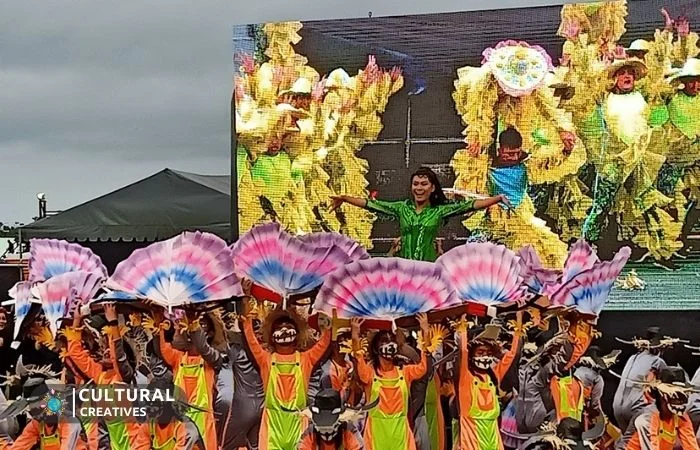
The vivid and lively Bambanti Festival pays homage to the unsung heroes of the agricultural fields – the scarecrows. Echoing the spirit and culture of Isabela, this festival has become a symbol of resilience, a beacon of hope and pride for Isabelinos, and an inviting tourism magnet that draws visitors from around the globe.
The Origin Story Of Bambanti Festival
Diving into the festival’s roots:
- Reflection of gratitude: It translates the farmers’ appreciation for their bountiful harvests and the scarecrows’ role as protectors of their crops.
- Commemoration date: Held annually during the last week of January, it coincides with the peak of the agricultural cycle in the province.
A Tapestry Of Colors And Creativity
The festival is not just a feast for the eyes, it’s also a soulful experience that encompasses:
- Cultural exhibitions: Local talents and traditions are showcased through costumes and innovative scarecrow portrayals.
- Competitive spirit: Various competitions include dance showdowns and scarecrow pageants, igniting a sense of camaraderie and local pride.
Savour The Flavor – Culinary Adventures
Feasting is integral to Bambanti Festival, where:
- Local cuisine takes center stage: Visitors can dive into Isabela’s rich culinarian heritage, sampling traditional dishes and local delicacies.
- Culinary contests: These cook-offs celebrate the inventive and delicious interpretations of homegrown ingredients.
A Catalyst For Unity And Progress
At its core, the Bambanti Festival drives unity and progress:
- Engaging communities: It is instrumental in fostering togetherness as townsfolk collaboratively prepare for the festivities.
- Boosting tourism: The increase in visitors translates to heightened economic activity, benefiting the local community significantly.
The Rhythm Of Bambanti Beats
Music sets the rhythm of the festival. Drumbeats and folk music amplify the excitement, lacing the atmosphere with infectious energy. Performances range from traditional to modern, reflecting the dynamic cultural tapestry of the region.
Epitome Of Innovation And Tradition
In culmination, Bambanti Festival stands as a testament to:
- The harmonious blend of innovation and tradition: It mirrors the progressive thinking of Isabelinos while respecting their rich historical heritage.
- Symbolic representation: The festival not only supports agricultural appreciation but also showcases the evolution of cultural expression.
The festival’s multi-layered impact, from fostering cultural pride to driving economic benefits, underlines its integral role in enriching the Philippines’ festival calendar. Its enduring allure is a narrative of community, creativity, and celebration – gateways to understanding the heart and soul of Isabela.
31. masskara
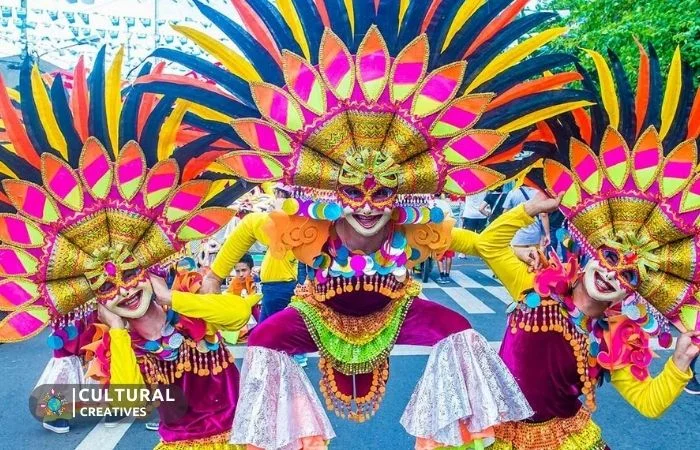
Imagine a street brimming with colors, rhythmic beats echoing through the air, and a sheer jubilance that envelops you. Welcome to the Masskara Festival, the Philippines’ annual explosion of joy and opulence that transforms the city of Bacolod into a canvas of cultural artistry and merry-making.
Let’s dive into the riveting details of this remarkable festivity.
History And Origin
- Birthed from adversity: This festival emerged in the 1980s as a response to a period of crisis in Bacolod, aiming to uplift the spirits of the locals.
- Symbol of resilience: The use of masks with smiling faces represents the collective strength and positive outlook of the people, hence earning Bacolod the title “The City of Smiles.”
Main Attractions
The Masskara Festival is not just a superficial display of fun; it’s an intricate tapestry of events that showcases the Filipinos’ indomitable spirit.
- Dance competitions: Watch as groups adorned in dazzling costumes and intricate masks perform synchronized dance routines that are nothing short of mesmerizing.
- Street parties: The energy is contagious with live music and dancing on the streets, ensuring that the festival’s pulse is felt at every corner.
Cultural Significance
- Expression of identity: This festival is a reflection of the town’s rich history and the locals’ unwavering optimism, even in face of challenges.
- Boosting community spirit: It serves as an anchor for community unity, as residents work hand in hand to orchestrate and participate in the grand event.
Festival Tips
Before you join the festivities, consider these pointers to maximize your Masskara experience:
- Best time to visit: Schedule your trip around the festival’s peak, usually the final weekend of October, for the full spectrum of activities.
- Safety first: Amidst the excitement, always be mindful of your belongings and personal space to ensure a bother-free celebration.
Through this dynamic festival, Bacolod not only showcases its cultural vibrancy but also its ability to turn a collective frown upside down. The Masskara Festival is a brilliant embodiment of Filipino craftsmanship, community, and the unwavering human spirit—an experience that transcends its locale to touch the hearts of visitors from across the globe.
Conclusion
Exploring festivals in the Philippines offers a tapestry of culture and joy. Each event celebrates the nation’s spirited heritage, uniting locals and tourists in unforgettable revelry. For your next venture, consider timing it with these lively gatherings. Embrace the Filipino spirit—it promises memories that dance to the heartbeat of these islands.






